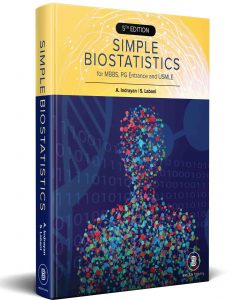Simple Biostatistics, Fifth Edition, comprehensively covers the biostatistics syllabus of MBBS, PG Entrance and USMLE examinations. What distinguishes this book from other such books is the error-free text from highly reputed authors, exercises and multiple-choice questions at the end of each chapter on the pattern of the competitive examinations, and a complete orientation to medical issues. The book gives heuristic explanation of the statistical methods and keeps away from mathematics, except as needed for the examinations. The text of the book will greatly assist in scoring full marks in your examinations. It will also help in greatly improved subsequent medical practice, particularly in understanding how biostatistics plays a key role in managing medical uncertainties and helps in reaching to evidence-based decisions for correct diagnosis and treatment.
Features
• Provides exercises and MCQs at the end of each chapter and their solutions at the end of the book
• Each chapter starts with a set of medical problems and brings in biostatistics methods to solve those problems
• The book provides a formula sheet of various health indicators and statistical tests and gives health statistics sheet with the latest data
1. Introduction to Biostatistics
1.1 Meaning of Biostatistics
1.2 Sources of Medical Uncertainties
1.3 Role of Biostatistics in the Management of Medical Uncertainties
1.4 Biostatistics in Health Planning and Medical Research
Exercises
2. Sources of Existing Medical Data
2.1 Health Information System
2.2 Patients’ Existing Records
2.3 Web-Based Resources
2.4 Government Records
2.5 Reports of Various Agencies
Exercises
3. Designs of Medical Studies
3.1 Fundamentals of Designs
3.2 Sampling for Descriptive Studies
3.3 Designs for Analytical Studies: Prospective, Case–Control and Clinical Trials
Exercises
4. Data Collection, Types and Their Quality
4.1 Tools of Data Collection
4.2 Types of Data: Qualitative/Quantitative, Nominal/Ordinal/ Metric, and Continous/Discrete
4.3 Quality of Data: Validity/Reliability, Sensitivity/Specificity, and Predictivities
Exercises
5. Measures of Morbidity and Mortality
5.1 Percentage, Rate and Ratio
5.3 Mortality Indicators
5.4 Crude and Standardized Death Rates
5.5 Expectation of Life
Exercises
6. Measures of Fertility, Demography and Social Health
6.1 Fertility Indicators
6.2 Demography
6.3 Indicators of Social and Mental Health
Exercises
7. Summarization of Medical Data
7.1 Tabular Representation
7.3 Summarizing Uncertainties: Probability
7.4 Numerical Summarization
7.5 Reference Range
Exercises
8. Strength and Type of Relationships: Regression, Correlation and Association
8.1 Type of Relationship in Quantitative Measurements: Regression
8.2 Strength of Relationship Between Quantitative Measurements: Correlation
8.3 Association Between Qualitative Attributes: Relative Risk and Odds Ratio
8.4 Cause-Effect Relationships
Exercises
9. Confidence Intervals (CIS)
9.1 Point Estimation and Standard Error
9.2 CI for Mean and Difference in Means
9.3 CI for Proportion and Difference in Proportions
9.4 Sample Size in Estimation Setup
Exercises
10. Tests of Statistical Significance – I
10.1 Court Judgement, Type I, Type Ii Errors, P-Value, and Power
10.2 General Principles of Statistical Tests
10.3 Student’s t-Test
10.4 Outline of Anova f-Test for more than two Groups
Exercises
11. Tests of Statistical Significance – II
11.1 Nonparametric Tests
11.2 Chi-Square Test
11.3 Z-Test for Proportions
11.4 Medical Significance and Statistical Significance
11.5 Sample Size For Test of Hypothesis Setup
Exercises
Health Statistics Sheet
Formula Sheet
Solutions to Exercises
Practice Questions at Advance Level


